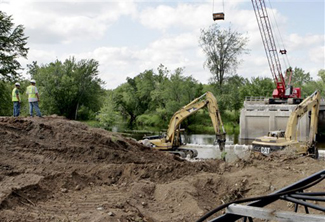| Home | Blog | Ask This | Showcase | Commentary | Comments | About Us | Contributors | Contact Us |

Using the Web to track stimulus spendingASK THIS | August 220, 2009News organizations need to keep up their reporting on how stimulus funds are being spent, and a great deal of help is available online. By Alex Byers Q: How is stimulus money being divvied up in your area? How much is going toward transportation infrastructure? How much to energy improvements, or to school systems?
Q: What companies are winning the big stimulus contracts?
Q: How is stimulus spending overseen once contracts are awarded and projects begin?
Q: Is the money going where it’s most useful?
Checking in at nearly $800 billion, the Obama Administration’s stimulus bill is one of the U.S. government’s largest expenditures of all time. Keeping track of where all cash is headed is a daunting task, but one that news organizations need to visit and revisit frequently.
There are some excellent online resources to help get started. The bill has its own Web site where anyone can track how money is being spent at the national level. In addition, other government agencies have places online to monitor stimulus spending in their policy area. There are sites that break down spending by state or territory as well. These sites can provide details on projects that are already under way.
Planning ahead is important. With so many projects being started, blindly searching for projects in your area may not be the most efficient method. Instead, contact state and local government sources to find out what projects are ongoing or beginning soon. Then, check the recovery sites for details on each project.
Go beyond details in paperwork, though. If you’re covering some kind of project that involves construction, get out to the construction site and check if the project appears to be on schedule, how it’s affecting the surrounding area, and how it might benefit the area once it’s complete. The Milwaukee Journal Sentinel sent reporters to rural Wisconsin to see how helpful upgrades to certain bridges would actually be – they found that some bridges were rarely used and possibly a poor destination for stimulus funds.
Another option is to consider using Web 2.0 technologies to collaborate with or learn from other reporters covering similar topics across the country. ProPublica is launching a program that will utilize journalists and citizens across the country to cover the stimulus from a national perspective. Consider using the new reporter’s tool, reportingon.com, too – it’s a site where reporters can solicit advice from other journalists on any story beat they choose.
Of course, tackling the stimulus simply by talking with local sources can be effective as well. Gauging the satisfaction and opinion of the public can be a good barometer of how useful projects may be after completion. In addition, address any statements or guarantees made by those in control of stimulus spending. The recovery act was designed in part to create jobs across the country – ask local contracting and construction companies, restaurants, information technology companies, and many others if they are seeing economic boost, or whether they’ve been able to hire more employees.
|


